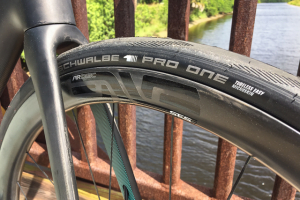Many of you know ENVE Composites as one of the top carbon wheel brands. What you might not know, however, is their depth of experience as an actual manufacturer of goods. End consumers often have no idea where the things they buy are made, nor the incredible challenges that come with running a factory. When it comes to the bicycle business, the majority of brands do some or all of their own engineering work, but rely on a third-party factory to actually make the stuff.
We had a chance to get a full tour of ENVE’s facility in Ogden, Utah, to see the huge spread of products that are made in their massive facility. They’ve only been in this new location for a few years, and as someone who has been on a lot of factory tours, I can say that this one ranks at or near the top for output, cleanliness, and investment in unique machines and processes.
If you missed it, we also spent some time in their on-site test lab, which handles the measurement, testing, and smashing of wheels, tires, forks, handlebars, and tires.

We began our tour in the giant machine shop, which is big enough to be its own factory. Above, ENVE’s Jake Pantone gives the lay of the land to our publisher, Dan Empfield. The room has multiple CNC machines, a water jet cutter, mills, lathes, and more.

Large plates of aluminum come in – the raw material for what will become wheel molds. Here, a water jet cutter cuts out sections that will eventually be rim O.D. tooling.

Those cut-out aluminum sections head into a CNC machine for further shaping. These are responsible for why ENVE supports hookless rims in general – because these mold pieces result in a super precise rim outer diameter, compared with the flexible materials that must be used for molding hooked rims.

With so much metal work going on, there are literal dumpsters full of aluminum shavings.

Huge rolls of carbon come out of storage in a massive walk-in freezer and into the cutting room. Here, they are hand-laid in specific orientations, to be cut in to pieces of all shapes and sizes.

Each tray you see here has all of the pieces for one rim. They are all carefully packaged, counted, and weighed – with each rim requiring a unique recipe.

The SES Disc wheel gets its own unique lay-up process, seen above.

As we moved into a completely different area, we found many different products being produced including carbon stems, and frame components like down tubes, top tubes, and seat stays. Above, we were in a room dedicated to smaller parts production, such as their carbon road hubs.

After molding, they end up in a finishing room with skilled workers and a full paint shop.

This area also handles completion of the disc wheels, which are checked for trueness and roundness.

Carbon rims are finished in a different room, where this robot performs sanding duties. It picks up one rim at a time from a stack, moves it around in multiple planes to evenly sand each rim edge, and sets it down in a different stack of finished rims. This is one area where having a machine perform the task is better than human hands, as it can apply a much more exact and consistent amount of sanding (something that’s critical when considering things like the necessity for even braking surfaces on rim brake wheels).

ENVE molds the spoke holes into each rim for improved strength, whereas most manufacturers drill the holes. However, this machine drills access holes on the outer wall of the rim for wheel building purposes – an area that doesn’t experience the same high loads.

Moving out into the warehouse portion of the building, we found hundreds of finished rims on racks, waiting to be built into wheels or shipped to distributors.

While many new bikes have disc brakes, ENVE has continued to refine and improve their rim braking surface. It has a textured surface that’s molded into the rim, along with a more temperature-resistant resin that has eliminated heat-related warranties.

Wheel building is the final step before shipping, and could easily deserve a tour of its own. Initial spoke installation is done by machine, but then the build process goes into human hands for tensioning and checking. A positive note to you mechanics out there - ENVE made the switch to brass spoke nipples, adding a few grams but greatly increasing longevity in corrosive environments.
While we couldn't quite show you everything that goes on inside ENVE's facility, we hope you enjoyed this glimpse of the highlights. While ENVE does manufacture some less-IP-intensive parts in Asia (such as handlebars), we were surprised at very versatile capabilities and sheer output of their US headquarters.



